Breeding for Polling in Cattle
Breeding polled cattle can be of benefit to farmers by leading to easier management and a reduction in injuries to stock. However in order to implement a successful breeding program it needs to be known whether a bull carries one or two copies of the polling gene.
Polling in cattle
What is Polling?
The original wild strains of cattle were horned. Polledness is a genetic mutation that causes animals within a horned cattle breed to not develop horns. The level of mutation is low; for every 20,000 calving’s where a horned cow is put to a horned bull, one calf is likely to be polled. This means that it takes a very long time for polled genetics to naturally arise and progress through a breed.
Polling is the process of breeding animals without horns from a breed that traditionally have ancestry with horns. Due to the low rate of naturally occurring polled animals; this is typically done by crossing in genetics from a naturally polled breed such as the Aberdeen Angus.
The Genetics of Polling
The presence or absence of horns is controlled by a major gene and there are two forms of the gene that control horn development. Each animal has two copies of the gene, which are inherited their parents. Offspring receive one copy from their sire and one from their dam. The two forms of the gene are:
P – This form causes polling and the capitalisation of the letter indicates it is dominant over the other form
p – This form causes horns and the lower case styling indicates that it is recessive to the other form.
When the two copies (one from the dam and one from the sire) are combined together in the offspring we refer to the resulting combination as the genotype of the progeny. The physical appearance of the animal that can be observed is called the phenotype. With the genes for polling there are three possible genotypes that can be created but only two phenotypes – horned or polled:

|
Genotype |
Phenotype |
Appearance of offspring if mated to horned cattle |
|
PP |
No Horns (Polled) |
Will not produce horned offspring, but calves may have scurs |
|
Pp |
No Horns (Polled) |
On average 50% of offspring will be horned and 50% polled |
|
pp |
Horns |
100% of offspring will be horned |
In the simple example below a bull with two copies of the dominant polling gene (P) is bred with a horned cow with two copies of the recessive form of the gene (p) for horns. Their offspring would all have the genotype Pp. The calves would all appear polled, though some may display scurs, but they would still have the potential to produce up to 50% polled offspring if they were mated with a horned animal because they are carriers for the p gene for horns.
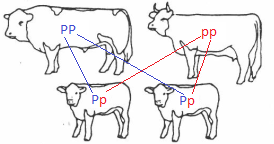
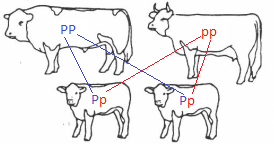
In this more complex second example a dam and sire are bred together who both contained one copy of each type of the gene (both polled and both genotype Pp).
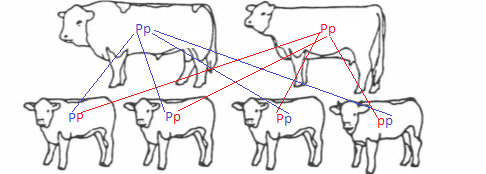
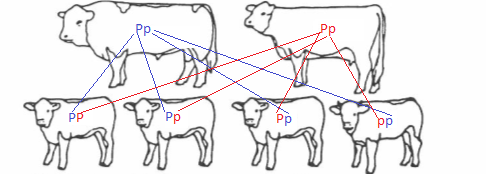
Within the resultant offspring 75% of the calves will be polled and 25% will have horns. Only 25% however will have two copies of the dominant polling gene (P) and therefore “breed true” producing only polled offspring. The half of the progeny that carry one copy of each gene (Pp) will still have the potential to produce both polled and horned offspring as explained in the above example and this is why it is difficult to eradicate horns all together. Interestingly 25% of the calves from these two polled animals will have horns – as they receive a copy of the recessive form of the gene from each parent
Scurring
An added complication when breeding for polling is the issue of scurring which can occur. Scurs are small growths of material very similar to horns that can develop in polled cattle.
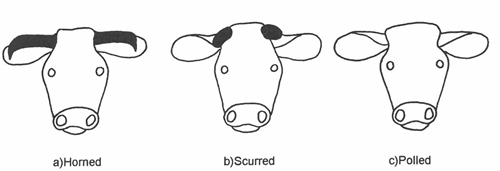
Traditionally it has been believed that scurs are sex-influenced due to the fact that they have been shown to be more common in bulls than cows. An example of this is that when Aberdeen Angus cattle are crossed with Brown Swiss the result is scurred bulls and smooth polled (non-scurred) cows.
Similarly to polling there are two forms of the gene that control whether an animal has scurs. Again these are inherited from the parents with the offspring receiving one copy from the Sire and one from the Dam. The two forms are:
SC – This form causes scurring and the capitalisation indicates that it is dominant over the other form
sc – This form causes smoothness and the lower case styling indicates that it is recessive to the other form.
However there is an added complication because the genes controlling scurs are also affected by the presence of the genes for polling. For a bull to develop scurs they must have a copy of the recessive form of the polling gene (p) and one copy of the dominant form of the scurring gene SC. Heifers however must have two copies of the dominant form of the SC gene to have scurs along with a copy of the recessive form of the polling gene (p).
The outcomes of the different genotypes in the different sexes are outlined in the table below (scurred cattle are highlighted):
|
Genotype |
Phenotype - Bulls |
Phenotype - Cows |
Notes |
|
PP SC/SC |
Smooth Polled |
Smooth Polled |
In all of these cattle the genes for polling appear to be dominant so the cattle appear smooth polled |
|
PP SC/sc |
Smooth Polled |
Smooth Polled |
|
|
PP sc/sc |
Smooth Polled |
Smooth Polled |
|
|
Pp SC/SC |
Scurs |
Scurs |
The presence of two copies of the SC gene and a copy of the p gene causes scurs in both bulls and cows |
|
Pp SC/sc |
Scurs |
Smooth Polled |
The single copy of the SC and p genes lead to scurs in the bulls but not in the cows where a further scurring gene would be needed |
|
Pp sc/sc |
Smooth Polled |
Smooth Polled |
Both bulls and cows appear smoothly polled as only the recessive forms of the scurring genes are present |
|
pp SC/SC |
Horned |
Horned |
In all these cattle the genes for horns mask the effect of genes that would cause scurs |
|
pp SC/sc |
Horned |
Horned |
|
|
pp sc/sc |
Horned |
Horned |
Practical issues with selecting for Polling
Polling is a trait that many breeders are looking to select for for many reasons including:
- Injury to other cattle from horns.
- Larger space requirements for transporting horned cattle
- Stress caused at de-horning can reduce performance.
- Risk to staff during handling of horned cattle.
The selection for the polled trait is made complicated however by the inability to visually distinguish between a polled animal carrying two copies of the gene and an individual with only one copy. This is especially important in polled bull selection because a bull with two copies of the polling gene (PP) will only have polled offspring.
Historically two copies of the gene in a bull has been detected using test mating programs whereby a polled bull is put to horned cows. If after multiple matings no horn calves are produced the statistical likelihood of him being PP over Pp increases, however if a single horned calf is produced then the bull must contain one copy of each form of the gene (Pp). The development of DNA testing techniques allow for a speeding up of the process through testing at the DNA level for the presence of the two genes. Challenges with the use of gene tests can be the costs involved, availability of the service and the potential for inconclusive test results.
Conclusion
To have a successful polling breeding programme
- The polled animals need to be of an acceptable quality for other traits of interest
- Several polled breeding lines are required to minimise inbreeding
- Pedigree’s and records of horns/scurs need to be accurate
- Investment in gene tests can greatly speed up progress
- Large numbers are advantageous – so it is beneficial if breeders work together and share information/breeding lines
All images from:
The Polling of Limousin Cattle in France and North America with a Review of the United States Beef Industry by James Milligan-Manby, November 1994, Nuffield Farming Scholarships Trust